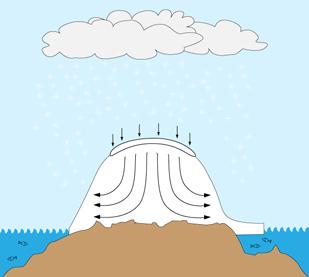Understanding the Greenland Ice Sheet
Introduction
80 % of the world’s largest island is covered by an enormous ice sheet. The Greenland Ice Sheet has developed over many thousands of years. Layers of snow have year after year accumulated and gradually been compressed to ice. The dome of ice is currently more than 3000 meters high at its top. The total volume of the ice sheet is approximately 2,900,000 km3. If that mass of frozen freshwater should melt altogether it would raise global sea level by approximately 7 meters.
Mass balance out of balance
Until recently, the mass was roughly in at state of balance. That is, the amount of snow falling on the surface was the same as the mass leaving the ice sheet as melt water runoff or discharge of icebergs. The Greenland Ice Sheet now loses more mass than it receives.
A model of the mass balance that includes data even before the satellite-era shows that since 1840, precipitation (in the form of snow) has risen by 12-20 %, the amount of melt water runoff has increased by approximately 60 %, and the output from glaciers has risen by approximately 40 %.
In total the loss of mass from the ice sheet equals a 25 mm addition to global sea level since 1840.
This development seems to have accelerated within the last decades. The largest ice loss rates since 1840 have occurred in the most recent decade. The mass loss in 2012 set a new record. According to the UN Intergovernmental Panel on Climate Change, the ice sheet lost 34 gigatonnes (1 Gt is 1 billion tonnes) annually in the period 1992-2001, corresponding to 0.1 mm annual sea level rise. In 2002-2011, the ice sheet lost 215 Gt per year (0.6 mm annual sea level rise).
The explanation for the increasing loss of mass is the rise in temperature.
The average annual air-temperatures measured since 2005 are the highest since measurements started in the late 1800s. The summer air-temperature in the Arctic in the last two decades is higher than at any point in time in the last 2000 years.
But also ocean temperatures have been rising - and that is most likely the explanation for why the discharge of ice from the marine terminating glaciers has accelerated. The ice sheet meets, so to speak, rising temperatures from above as well as from below.
The big questions
How will the ice sheet respond to the even larger increase in temperatures we should expect in the future? So far, the air temperature in the Arctic has risen by approximately 1.5°C. Climate models predict an increase of up to 5-10°C within this century.
How large will the loss of mass be in a warmer future? How much freshwater will the Greenland Ice Sheet add to global sea level? These are simple questions that are asked more and more frequently. For obvious reasons. We are dealing with the second largest mass of ice on the planet, and the mass loss affects the life of millions of people in many cities around the heavily populated coastal regions of the globe.
It is hard to say exactly what will happen in the future. The ice sheet is constantly flowing slowly from the center towards the ice sheet margin. But how will this flow react to increasing temperatures? And how will the ice sheet react to increased melt water in crevasses? What will happen to the ice sheet reflectivity with increased melt?
What exactly is going on at the edges of the marine terminating glaciers? How exactly does the ice sheet and the ocean interact? These are some of the questions scientists are trying to answer.
Small changes in the permafrost can have dramatic consequences
The definition of permafrost is when the temperature in the subsurface and the ground does not exceed 0°C in periods of more than 2 years. There is permafrost in most Artic areas.
The top layer is more easily influenced by the temperatures of the air and exceeds the freezing point some time during summer. This layer is called the active layer. In several areas the active layer of the permafrost has become deeper in recent years. Consequently, the permanently frozen subsurface is located further down. And even if the ground in 2-3 meters depth is permanently frozen, the temperature still rises to warmer and warmer negative temperatures in several places.
It can sound quite harmless if the temperature rises from minus 2 to minus 1.8°C. However, these seemingly moderate changes are warnings of a development that can be very difficult to revert, because the permafrost system is a very slowly reacting system.
If the permafrost thaws, it will have big consequences in rural districts. Houses, roads and pipelines can for example lose their stable and firm foundations. And animals can find difficulty in scaling the areas of land and finding prey.
The permafrost also binds enormous amounts of carbon consisting of decayed and transformed biological material above ground and as gas hydrates under the sea bed. If the permafrost thaws, large amounts of this carbon can be released into the atmosphere consisting of carbon dioxide (CO2) and methane (CH4). It has been estimated that the amount of carbon bound in the permafrost exceeds the amount of CO2 in the whole atmosphere.
The development of the permafrost has been monitored for the past decades. The development shows that the areas with permafrost and the actual depth of the permafrost are becoming smaller. According to the SWIPA report from the Arctic Council in 2011, the permafrost in the Arctic has become up to 2°C warmer and has therefore vanished in several places in the southern part of the Arctic. The southern border for permafrost has in this way retreated 30-80 km northward in Russia between 1970 and 2005 and 130 km in Quebec over the past 50 years.
For more information see Links.






